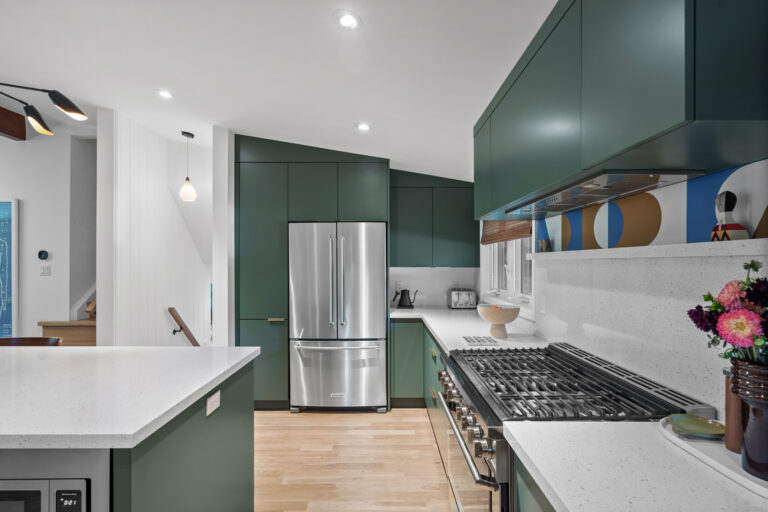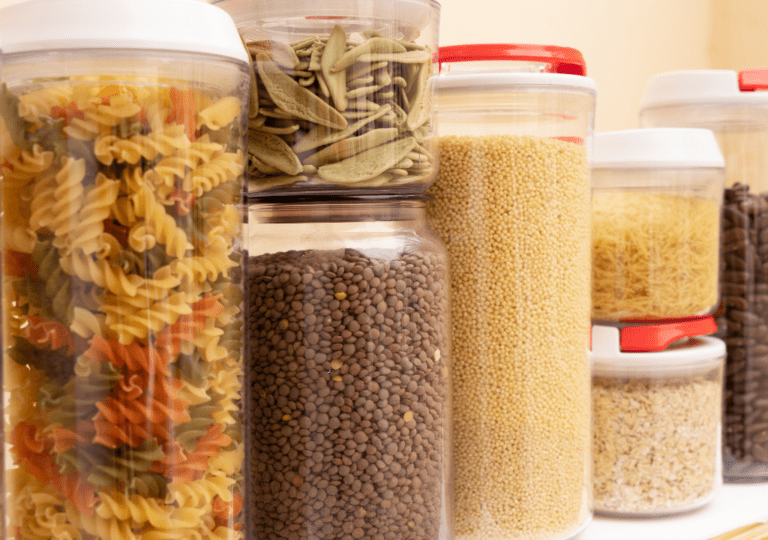Salad
While spending a Sunday afternoon with your grandma in the kitchen, pay close attention. She may have a few tips and tricks for the kitchen up her sleeve you never knew about.
In this list, we here at Decor wish to share some of those kitchen tips for the home with you.
1. Storing Newspaper with Containers
If you’ve ever had a smelly Tupperware container, then you know how it can make other foods smell and taste bad if they’re also stored in the same container afterward. Instead of throwing the containers away, crumple up newspaper and stack the containers together, storing them like this overnight.
Make sure to thoroughly clean the containers afterward.
2. Overboiling Pot?
Ok, so this one is quite common. Probably one of the first tricks you’ll learn in the kitchen.
When boiling anything on the stove, place a wooden spoon across the top of the pot. The spoon stifles any initial overboiling until you can act accordingly.
Choose a wooden spoon you don’t mind getting warped from the steam.

3. Socks, Coffee, and Chill
After a while, your freezer may gain a musty smell. Especially if the unit is getting on in years. To mitigate this smell, use a clean sock fresh from the laundry, especially if it has lost its other half. Brew and enjoy some coffee, but don’t throw out the used granules. Stuff the sock about halfway with these granules, tie the sock tightly and stick it in the freezer overnight. By the next morning, you should smell a difference.
Who knew that coffee and socks would go so well next to frozen veggies?
4. Onions are Not Worth Crying Over
Swimming goggles are a good place to start while cutting onions.
As a further measure, peel and place the chosen onion in the freezer for about 30 minutes, then cut away. Keep in mind your hands may get a little cold while cutting.
Sticking a piece of bread in your mouth works as well. The bread will absorb most of the “crying chemicals” from reaching your eyes. Although you may look a little fun while doing so.

5. Boiled Eggs
While boiling eggs for a wonderful breakfast, the raw egg will sometimes escape the mixing receptacle or pan.
Toss some salt onto the spillage, and it’ll soak everything right up. Scrub away the effects, and none will be the wiser to this “as-salt”.

6. Get Rid of The Fishy Smell
The fish smell can be quite strong. To rid the smell of fish from the box of convenience, place some dish soap onto a damp paper towel, warm it up for a few minutes in the microwave, let it sit for approximately a half hour, then wipe everything down.
The smell will have disappeared.
7. Defrost With Aluminum
While defrosting raw meat under a cold running tap is the quickest method, it can cause a slightly larger water bill.
To help save some money, place the meat on an aluminum tray since this type of metal is a great conductor of heat. It is also a better alternative to a wooden cutting board.
8. Tupperware vs. Deli Containers
It’s always frustrating to open your plastic container drawer and never be able to find a matching lid to the container.
Instead, purchase plenty of deli containers in varying sizes with matching lids. These containers are a bit more flexible so it’s easier to pour out of, they’re see-through making it easier to see what’s inside, the lids will always match, and they are extremely cheap compared to the alternative.

9. Trays of Flavored Cubes
If you wish to not water down your soda with melted ice, then freeze your favourite fizzy drink in a designated ice cube tray. Now you’ll still have a cold drink with ice cubes without losing flavour.
After a night with friends and/or family, you can also freeze any leftover wine in an ice cube tray as well. The frozen wine ice cubes will be perfect for reusing in sauces or if you wish to have chilled wine on a hot day.
10. Keeping brown sugar soft
You can keep your brown sugar from getting hard. Simply store it in a resealable plastic bag and squeeze all of the air out, keeping it within an air-tight container. For extra insurance, just add a slice of bread to the bottom of the bag. This will bring just enough moisture to hydrate the molasses.

11. Conserve Parsley
You should wash it thoroughly if you plan on keeping fresh parsley in the refrigerator for several days. Then dry them with a paper towel, put them in a plastic bag, and put them in the freezer.
When you want to use some, just take a small piece of parsley and crumble it into a bowl to use in soup, stew, or any other dish. This is how you can stock any fresh herbs.
12. Cleaning cups
To eliminate coffee or tea stains, wet your cup with baking soda. Use a clean dish towel to rub in the baking soda. Then fill the container with warm water, add a squirt of dish soap and rinse out the cup. Repeat until satisfied with the result.
13. Instant oatmeal flour
Process the oatmeal by mixing it with a food processor. In one tbsp of oat flour, combine one cup of fast-cooker or traditional oatmeal and grind it into coarse flour. Oats are naturally gluten-free, so if a recipe calls for oat flour, chances are it will most likely also be a gluten-free meal.

14. Enhance Grill Marks
Put a small amount of honey in a marinated dish before grilling. Honey caramelizes and helps to form gastronomic marks. Use this trick next time while making food in your kitchen. This will be one of the best kitchen hacks to know in the future.
15. Lemons are very versatile.
You can use lemons beyond tea or cocktail garnishes or as a topping for baked fish. The lemon is one of the most versatile foods in your kitchen. You can take half a lemon and a sprinkle of salt on your cutting board and rub them in to eliminate any smell.
You can get the best lemon juice out of fresh lemons. Lemons should not be frozen to be able to squeeze out the most lemon juice possible. To release the most juice, roll firmly on the countertop, microwave for 10 to 20 seconds, or soak in a bowl of warm water for 30 seconds up to several minutes before cutting. Then cut it in half and squeeze.

16. Sweet Smelling Kitchens
To eliminate awful cooking smells and make your kitchen smell amazing again, boil some spices, orange slices, and cinnamon sticks in water for several minutes. It’s fun, during the holidays, to have your home smell inviting to the occasion. Having family gatherings will be that much more enjoyable.
17. Partially freeze meat before cutting
When cutting meat into thin slices or strips while it’s still raw, it’s easier to put it into the freezer for about 15 to 30 minutes, sometimes even up to an hour before cutting, to partially freeze it. It helps firm up the meat, making it easier to slice. If you just took the fresh meat out of the freezer, slice it before it is completely thawed.
18. Next Level Ice Cube Tray Hack
There are many things you can use your ice cube tray for, not just for freezing water. Use it to freeze milk or cream into cubes that you can use for your coffee. You can freeze ice cubes of lemon juice. And you can say goodbye to watered-down iced coffee by freezing your coffee into ice cubes
19. Marinating Chicken
You can tenderize your chicken with enzymatic ingredients like yogurt, milk, honey, or pineapple juice.
Use them instead of, or combine them with, an acid ingredient like vinegar or lemon and lime juices with a fat ingredient like vegetable, nut, or chile oils and additional seasoning, including spices, herbs, syrups, zests, and any secret ingredients that make your marinated chicken recipe a signature meal. The possible combinations of flavour are endless.
20. Strawberry hacks
Did you know that you can make delicious candy from strawberries by over-drying them? Yes! But they are naturally sweet, healthy, and so good for you. Simply cut your strawberries and place them on a foil-lined baking sheet in the oven at 210 degrees for about three hours.
Another great trick with strawberries is removing stems with a straw. It’s so easy, and most of the strawberry stays intact. Simply use a straw and easily remove the stems. The strawberries will also be intact.

21. Coat your noodles in olive oil after you're done cooking
Never add olive oil to your pasta water. Instead, coat the noodles in olive oil after you’re done cooking them – and if you aren’t dressing them right away. This will prevent pasta from sticking. Who would want a gummy plate of noodles anyways?
22. Clean Oil Easily
Use a dabbing motion to soak up the excess oil with paper towels or old dish towels. Don’t wipe or else you risk further spreading all the oil. If a glass bottle also breaks, carefully pick up the glass and collect it in a brown paper bag before throwing it in the trash.
Sprinkle cornstarch over the rest of the oil and let it sit for about ten minutes. Cornstarch usually works well, but if all you have on hand is baking soda, then use that.
Vacuum up the cornstarch and wipe the surface using a small amount of dish soap and warm water.
23. Grate your own cheese
Grating cheese while making a meal can be time-consuming. Instead, grate your cheese ahead of time, then freeze it. Now, whenever you need grated cheese, take it out of the freezer, and you have cheese ready to go.

24. Bake Bacon
The easiest way to cook bacon, hands down, is to bake it! Preheat your oven to 400 degrees, put a cookie rack on a baking sheet, lay the bacon strips over the rack, and put it in the oven. Now cook until the crispness is just the way you like it. This should only take 10 to 20 minutes.
25. Scratch-free skewers
Place paper plates under stacked nonstick pans for protection against scratches when they’re stored away. Take advantage of this innovative way of keeping pots and pans from getting scratched, this way, the chances of something burning onto your pot or pan will be much lower.
26. Prevent Food Storage Stains
If the container has solid foods like tomatoes inside, cover the inside with nonstick baking spray. If you have things like pasta sauce, tomato paste, or soy sauce in the container, consider lining the container with foil or plastic wrap.
27. Freeze as flat as possible
Did you know you can freeze your soups and stews? Freeze the pieces flat and then stack them up. It’s all soup and stew, but the wider it is, the quicker it can freeze and thaw, the better.
Not only does this increase your efficiency, but it improves quality. Place foods into freezer packs and squeeze all the air out. When you store vegetables in the freezer, slice the fruit and vegetables into 1-inch-thick chunks and wash green vegetables with cold water.
28. Freeze wine for cooking in ready-to-use portions!
You can freeze wine in glass containers in the freezer or store it in ice trays that can be taken out later, ready for you to use for cooking.

29. Use a Scale for Baking
A good scale has two main uses for baking: precision and efficiency. Volumetric measurement in cups is extremely unreliable when weighing compressed food. Depending upon your grinding method, a gram of flour can be up to six ounces. The difference is 50%! With a scale, you will see if your flour cups are correct, which will help with consistency.
30. Turn away pan handles
Turn your pan handles away from you when cooking. This simple tip can save you not only from a big mess to clean up but also from burns and possibly slipping on hot oil if any spills on the ground.
31. Use the cheese grater to make tomato sauce!
Tomato season comes and only stays for a short period, which means grocery stores won’t be giving away tomatoes by the pound anymore. Grab as many as you can!
Let them sit on your counter and forget about them. When the time comes that they become so overripe that you’re tempted to throw them out, get out your box grater and make tomato purée.
From there, the opportunities are endless: you can mix the purée with garlic, basil, and olive oil and turn it into a no-cook tomato sauce; you can spread it on bread or just combine it with yogurt to make a quick party dip.

32. Read the recipe first
So, it should be quite obvious that reading the recipe first before you even start gathering the ingredients is the first step in cooking anything. Use your recipe not only to gather all ingredients but also to know which tools to use and to make sure you use them correctly. You don’t want to start cooking and realize later you used your tool incorrectly, and now you don’t have the consistency you need. Sometimes it’s the little things we need to be careful of.
33. Buy peeled garlic
When feeling a bit lazy or even rushed and you don’t want to pull out your full food processor but need some breadcrumbs that you can use as a garnish on a pantry pasta dish, your box grater comes in handy.
You can just toast a little bit of stale bread and grate it on the large holes to get perfect, toasty breadcrumbs. And not having to wash your food processor is the best part!

34. Make breadcrumbs with your cheese grater
When feeling a bit lazy or even rushed and you don’t want to pull out your full food processor but need some breadcrumbs that you can use as a garnish on a pantry pasta dish, your box grater comes in handy.
You can just toast a little bit of stale bread and grate it on the large holes to get perfect, toasty breadcrumbs. And not having to wash your food processor is the best part!

35. Use a honing rod to keep your knives sharp
You might have gotten a honing rod that came with your kitchen knife set. A honing rod is also known as a sharpening steel. It’s a long metal stick-like device that almost resembles a short sword. It helps realign the metal on your knife without removing a large amount of metal from the blade.
How do you use the rod? Hold your knife in your dominant hand and the rod in your other hand. Elevate the rod tip above its handle. While keeping your fingers away from the blade, hold your knife at a 20-degree angle from the rod. Move the knife across the top of the rod from the knife heel to the tip.
Repeat this motion at the bottom of the rod on the other side of the knife blade. A pass across the top and bottom is called a revolution. Do six to eight revolutions before using your knife. Start slowly at first until you get the motion down. The more you practice, the faster you get.

36. Using a cup or mug to sharpen your knife
If you don’t have any knife sharpening equipment, there are other sneaky ways to sharpen them with everyday kitchen items. One hack is to use the bottom of a ceramic mug or cup to quickly sharpen your knife. Maintain a steady angle of 20 degrees or so and slide the blade of your knife across the grit of the mug on both sides of the blade.
37. Get an Immersion Blender
Once you have it, you’ll use your immersion blender more than most electric tools in your kitchen. When making Mayonnaise or Hominy in less than 2 minutes, immersion blenders are the perfect tools for preparing your food. It’s also easier to clean compared to a regular blender and can be used to make even small batches of products using the correct cup.

38. Never drench your pancakes again
If you buy real maple syrup in quart jugs, you’re probably drenching your pancakes — so much so that you might be eating syrup with some pancakes, not pancakes with some syrup. Transfer the syrup to a squeeze bottle and never look back.
39. Grab a garbage can
For maximum efficiency in the kitchen, put a garbage can near your workstation whenever necessary. So, if you’re cutting vegetables, this can be handy. Getting rid of waste can become quite time-consuming and can cause you serious drudgery. Opt for efficiency.
40. Use your knives on the right surfaces
The condition of your kitchen knives depends heavily on the surfaces that you choose to use for cutting. Make sure to avoid any hard or metal surfaces, such as stainless steel, granite, and aluminum.
On the other hand, cutting on wood, plastic, or polyethylene is usually perfectly fine. As long as you are using a cutting board made out of the proper materials, you should be safe and good to go.

41. Replace butter with avocados
To slice an avocado for salads or sandwiches, cut them into two parts. Stick the blade of a knife to the seed to pull it out. Now scoop it out.
Did you know you can replace butter with avocados? Try it sometime. Smear some over your slice of bread, and put your toppings on.
42. Freeze your treats
When you make chocolate banana bread, and you don’t want to eat the whole thing, cut it into slices and freeze them individually. This way, when you want a treat, simply toast it. It can help savour baked goods and not feel the need to demolish them in one go. Use this technique with brownies, cookies, etc.
43. Peel Ginger with a spoon
Use a spoon to peel ginger. Scratch the spoon against the skin, and you can remove the skin quickly and minimize the mess you make. Grab a garbage can and peel directly into it.

44. Create flaky pie dough using a box grater
It’s a well-known fact in the baking world that you should use frozen or at least chilled butter to make the best pastry dough. But what about grated frozen butter? Grate the frozen butter before adding it to the flour. As soon as the butter hits the flour, it creates hundreds of tiny butter pockets, causing the dough to puff like crazy in the oven.
45. Avoid cross-contamination
Avoiding cross-contamination when cooking is vital, so you don’t spread any germs from any meat to the rest of your food or vice versa. Use separate cutting boards to achieve this. One for raw meat, poultry, and seafood, and one for everything else.
Final Thoughts
Are you feeling confident about your skills in the kitchen yet? We might not be able to turn you into a kitchen master, but these tips and tricks might just help you enough to boost your confidence in the kitchen.













